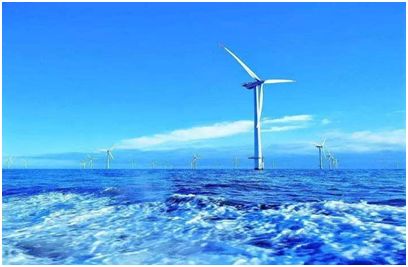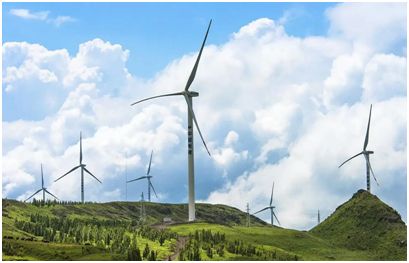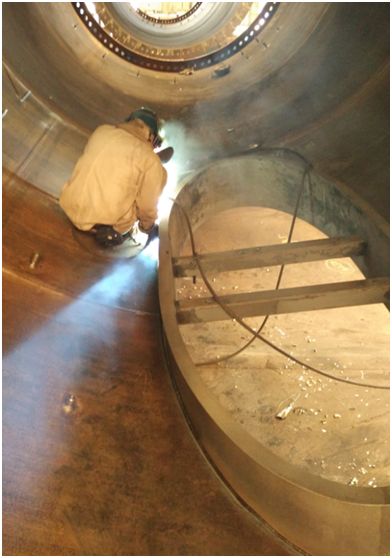Web:www.welding-honest.com Tel:+0086 13252436578
As a clean energy source, wind power has developed rapidly in recent years. With the development of wind power equipment, the steel plates used are getting thicker and thicker, and some have exceeded 100mm, which puts forward higher requirements for welding. At present, Q355 or DH36 is widely used in wind power equipment, and the welding methods generally choose flux cored wire gas protection welding (FCAW) and submerged arc welding (SAW).


In the process of wind turbine tower manufacturing, fine cracks are prone to occur in the fusion line or heat affected zone position after welding of the door frame, and the thicker the steel plate, the greater the crack tendency. The cause is caused by the comprehensive superposition of stress, welding temperature, welding sequence, hydrogen aggregation, etc., so it should be solved from many links such as welding material, welding sequence, welding temperature, process control, etc.

1、Selection of welding consumables
Because the welding part is very important, it is necessary to prefer welding materials with low impurity content, good toughness and good crack resistance, such as our GFL-71Ni (GB/T10045 T494T1-1 C1 A, AWS A5.20 E71T-1C-J).
Typical performance of GFL-71Ni products:
● Very low impurity element content, P+S ≤0.012% (wt%) can be controlled.
● Excellent elongation plasticity, elongation after break≥27%.
● Excellent impact toughness, -40 °C impact absorption energy ≥ more than 100J.
● Excellent CTOD performance.
● Diffusion hydrogen content H5 or less.
2、 Welding process control
(1) Welding preheating and inter-channel temperature control
Referring to relevant standards and comprehensive past experience, it is recommended to select preheating and inter-channel temperature:
● 20~38mm thick, preheating temperature above 75 °C.
● 38~65mm thick, preheating temperature above 100 °C.
● More than 65mm thick, preheating temperature above 125°C.
In winter, heat loss needs to be considered, so it should be adjusted up by 30~50 °C on this basis.
(2) The workpiece should be continuously heated during the welding process to maintain sufficient inter-channel temperature
● 20~38mm thick, it is recommended to control the temperature between channels 130~160 °C.
● 38~65mm thick, it is recommended to control the temperature between channels 150~180 °C.
● More than 65mm thick, it is recommended to control the temperature between channels 170~200 °C.
The temperature measuring device is best to use contact temperature measuring equipment, or a special temperature measuring pen.
3、Welding specification control
|
Welding wire Diameter |
Recommended parameters |
Heat input |
|
1.2 mm |
220-280A/26-30V 300mm/min |
1.1-2.0KJ/mm |
|
1.4 mm |
230-300A/26-32V 300mm/min |
1.1-2.0KJ/mm |
Note 1: Small current should be selected for bottom welding, and the filling cover can be appropriately larger, but should not exceed the recommended value.
Note 2: The width of a single weld bead should not exceed 20mm, and the weld bead should be arranged according to the actual situation. When the groove is wide, multi-pass welding should be used, which is beneficial to refine the grains.
4. Welding sequence control
It is best to use multi-person symmetrical welding for annular welds, which can greatly reduce shrinkage stress, and 4-person symmetrical welding is better than 2-person symmetrical welding.
5、Hydrogen removal in the middle of welding
The hydrogen removal in the middle section is a measure taken against the accumulation of diffusible hydrogen in the welding of thick plates. The research shows that the effect is obvious for thick plates larger than 70mm. The operation process is as follows:
● Stop welding to about 2/3 of the entire bead.
● Dehydrogenation 250-300℃×2~3h.
● Continue to weld until the completion of hydrogen removal.
● After welding, cover with insulation cotton and slowly cool to room temperature.
6. Other matters needing attention
● Before welding, the bevels should be clean and clean.
● Swing gestures should be avoided as much as possible. It is recommended to use straight welding bead and multi-layer multi-pass welding.
● The extension length of the bottom welding wire should not exceed 25mm. If the groove is too deep, please choose a conical nozzle.
● After the carbon planer is cleaned, the metal color must be polished before continuing welding.
We have a large number of application examples of welding consumables used in the wind power industry, welcome to inquire!
Post time: Nov-24-2022